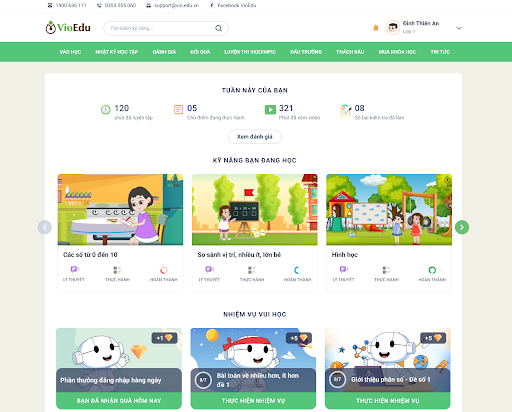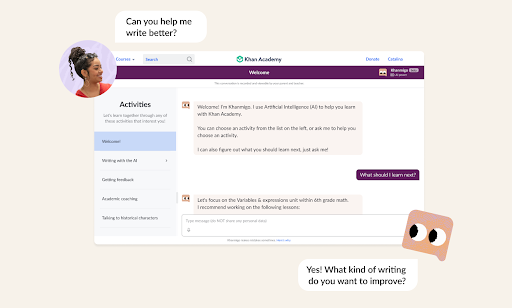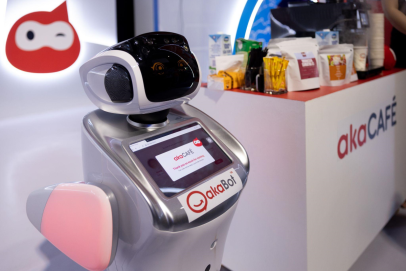Artificial Intelligence in Education: An overview
Artificial Intelligence (AI) is exploding and has the potential to change every aspect of human life. Education is not an exception to this trend, benefiting from many achievements of AI, from educational innovation to enhanced quality of sustainable development in the new era.
AI is gradually changing the way we teach and learn. AI-powered tools improve effectiveness, personalization, and accessibility in education. To apply AI effectively and sustainably, it is necessary to have an overview of AI in education, including understanding AI and the positive changes, as well as the challenges and barriers that arise when applying AI to education. From there, we propose some key solutions to overcome difficulties and gradually realize AI’s potential in the education sector.
“USD 2 billion was invested in applying AI in the education sector in 2020, despite the complexity of the COVID pandemic.” (Council of Europe)
“The global AI in education market is projected to grow at a Compound Annual Growth Rate (CAGR) of 36% from 2022 to 2030.” (Grand View Research)
1. AIEd – From the first footprints
Artificial Intelligence in Education (AIEd), which was developed in the 1970s, focuses on researching, developing, and evaluating computer software to improve teaching and learning. AIEd is linked to a long-term objective of gathering learner feedback, evaluating strengths and weaknesses, and personalizing education for an individual or group of learners. Furthermore, AI is also expected to be used to study teaching and learning theories (Beverly Park Woolf, 2015).
While AI puts machine learning and human-like intelligence at its core, education focuses on fostering learning capacity and human intelligence. AIEd knowledge helps close this gap by providing techniques to foster more efficient and intelligent interactions with humans to enhance educational outcomes. Researching and utilizing current AI-based products has improved the teaching and learning process.
Singapore launched the “Smart Nation” initiative in 2014 and has been steadily expanding it by leveraging AI to customize and improve the quality of education for every student. In South Korea, teachers have been able to use AI-based systems to adapt homework based on students’ educational levels. Embibe, an educational technology company in India, uses AI to clarify complex math and science concepts. Additionally, AI is being incorporated into the educational system through free online courses and instant feedback platforms such as ViLLE in Finland.
In Vietnam, the National Strategy on the Research, Development and Application of Artificial Intelligence until 2030, under Decision No. 127/QD-TTg dated January 26, 2021 decreed that the Prime Minister assigns the Ministry of Education and Training to oversee and coordinate with relevant ministries to conduct AI-related tasks until 2030. One of the key responsibilities is to promote the development and implementation of AI applications in education.
The application of AI for students in education takes place on three main “fronts”, including using teaching robots, developing AI, and building educational software solutions.
AI is transforming the education sector and opening up a wide range of new career opportunities.
2. Towards outstanding achievements in education
With its superior capabilities, AI has opened a new chapter for the education industry with its extremely diverse applications. Specifically:
2.1. Personalized learning paths
AI-based platforms or applications can collect and analyze student data on interactions with lectures, time spent to complete assignments, test results, and overall performance to understand the attitudes, behaviors, and demands of each student. Based on this data, AI tools will design and personalize learning paths for students and make real-time adjustments to fit their progress.
In January 2020, the Online Education System Vioedu, a smart learning assistant developed by FPT Corporation, was developed. This is a typical example of efforts to introduce AI to Vietnamese students, with a focus on the ability to personalize learning paths for each student. Vioedu can create hundreds of thousands of different learning and test preparation pathways for each student. The system will grade and assess each student’s comprehension of each subject based on the student’s answers, and provide the user with a unique “competency map” which highlights areas of strength and weakness where students need to improve.
Vioedu can create hundreds of thousands of different learning and test preparation pathways for each student.
Vioedu would function as a “compass” for users, guiding them on the most effective path of study and test revision, helping users focus on key information and close knowledge gaps to avoid wasted time and implicit learning.
2.2. Learning outcomes prediction
AI can be leveraged in education to improve the prediction of learning outcomes. This solution was developed based on machine learning, which processes previously collected data about student learning outcomes based on the criteria of performance, attitude, and social conditions., and classifies them into different patterns. The algorithms will then compare and determine the relationship between learners and typical characteristics associated with student learning outcomes. From there, it opens up opportunities for teachers to choose the best teaching methods and programs based on students’ skills and needs. It can even help identify students at risk of early dropout or graduation delay based on low test scores, poor academic performance, repeated absences, or tardiness, and provide them with support before it becomes too late.
2.3. Teacher work automation
AI can replace teachers in performing repetitive and time-consuming tasks such as evaluating tests with grading software to save time for interacting with students. In addition, AI has further advanced where the large language models (LLM) are applied to allow natural language processing to effectively support checking and evaluating answers, short essays, and students’ writing skills. (According to McKinsey & Company – How artificial intelligence will impact K-12 teachers).
2.4. Administrative work management optimization
Educational institutions can use AI to automate a wide range of administrative tasks, such as processing student applications, admissions, facility management, human resources recruitment, and more. This is one of the key factors in reducing costs, enhancing management efficiency, and improving the ability to meet student needs.
2.5. Academic support for “special” students
One of the meaningful humanitarian applications is the potential of AI to support “special” students’ learning Specifically, AI assistants can provide appropriate learning pathways and exercises so that students with disabilities have the opportunity to receive the best education possible. Typically, AI-powered text-to-speech software can read instructional materials aloud, providing blind students with equal learning opportunities.
2.6. Resource planning support
In addition to improving learning outcomes, AI has the potential to streamline school infrastructure management. For example: AI can perform resource planning tasks such as estimating the quantity of food, school materials, or stationery required and ensuring it is purchased and delivered in a timely manner.
2.7. Lesson plan design support
Building a curriculum is not always an easy task for educational managers, because the knowledge base is an element that requires ongoing innovation. AI is not only highly appreciated in planning personalized learning paths, but also for processing massive amounts of data about students’ progress, interests, skills, and even learning barriers for students in a particular year. This allows teachers or managers to make informed decisions about how to increase the effectiveness of curricula on a large scale.
Artificial intelligence (AI) algorithms are able to recognize patterns and trends, assess the effectiveness of particular pedagogical approaches, and predict the results of different educational strategies.
2.8. Continuous support during the learning process
The combination of adaptive learning based on machine learning and natural language processing enables virtual assistants to be increasingly flexible and a valuable “ally” for learners. Chatbots and AI tools run around the clock, helping students stay on top of their studies by giving them information, feedback, and support whenever questions arise.
3. Current outstanding AI technologies today
A variety of technologies and AI-powered software have been developed to serve the needs of teaching, learning and management in the education sector, including:
3.1. AI helps learners with
- Adaptive learning tools
- Concentration, empathy, and emotion measuring tools
- Virtual assistant chatbots
- Automated essay evaluation tools
- Personalized learning platforms
- Smart language learning applications
- Personalized content management platforms
AI tools that have been applied to education today include familiar names such as Got It, Chat GPT, Khan Academy, Vioedu, etc. These tools help motivate teaching and learning and foster logical thinking, questioning, critical thinking, and independent problem-solving skills.
3.2. AI helps teachers with
- Website scanning tools
- Smart course scheduling and planning
- Automatic assignment grading solutions
- Classroom management tools
- Curriculum design tools
- Student progress analysis platforms
Typical examples of these AI-powered tools that support teachers include the facial recognition attendance trackers used by many universities such as: FPT University, FPT Polytechnic Vocational College, Hong Bang International University, etc.
3.3. AI supports institutions and policies
- Personalized admissions management platforms
- Chatbots providing emotional support
- Resource planning systems
- Student dropout prediction tools
- Admissions forecast and management tools
- Campus safety and security tools
AI is currently being used extensively in the admissions management platforms in Vietnam. In 2023, the Ho Chi Minh City Department of Education and Training used AI to assist parents and students in registering for 10th grade admission options. Accordingly, the system provides detailed information about local high schools, including curriculum, admission scores, admissions targets over the years, and so on. In this way, AI will analyze and evaluate the results of high schools that are suitable for the students’ learning ability as well as their location.
4. Three practical applications of AI in education
Case study 01: The language learning app Duolingo is one of the best examples of an AI-based learning platform that integrates smart bots to interact with students. Duolingo’s famous tutor or mascot is a cheerful but insistent green owl that motivates users to engage in daily learning in a “special” way.
Additionally, Duolingo’s personalized learning methods include a placement test that evaluates the user’s skills and gradually adjusts the level of recommended activities based on his/her performance and previous results. The ultimate goal is to maintain an optimal level of challenge and sustain learners’ engagement, both with the help of a score-based reward system.
Case study 02: Based on the OpenAI platform, Khan Academy (an online learning platform) is testing an AI tutoring model called “Khanmigo”. This application helps students find a solution by offering suggestions and information relevant to the problem, rather than providing answers and solutions directly. Furthermore, parents and educators have the authority to keep an eye on the information shared between students and AI to make sure it is being used for the right learning purposes. In this way, AI can facilitate learning without demotivating students.
Khamigo is developed by Khan Academy.
Case study 03: StepWise is an AI-powered educational platform developed by US-based Querium with the mission of revolutionizing how students learn STEM subjects. The platform employs AI-based analytics to accurately assess the student’s progress in a given subject and provides personalized instructions based on the student’s individual learning needs.
The platform also uses machine learning algorithms to uncover difficult concepts and help the student better understand them. StepWise provides a comprehensive set of tools, such as interactive lessons, adaptive quizzes, and real-time feedback, to ensure that the student stays engaged throughout their learning session.
5. Challenges and proposed solutions when applying AI in education
The development of AI can threaten humanity’s existence and mastery of the world, which has the potential to make humans the second most intelligent species on Earth. In addition to the benefits already discussed in education, AI poses potential challenges and difficulties when applied in practice.
5.1. Data privacy concerns
AI applications normally require large data sets to operate effectively. This also raises concerns for the privacy and security of student information.
Recommendations: Educational institutions should have clear policies and procedures in place to protect student data privacy, including user authentication, limited access to sensitive information, and storage data encryption.
5.2. Deployment cost
Building and widely deploying AI tools can be expensive for schools due to the significant cost of developing hardware and software, as well as the time and money required to train human resources to apply new technology software.
Recommendations: Schools and educational organizations can lower the AI application cost by opting to purchase existing solutions rather than developing completely new ones. Schools can also collaborate with software providers and Edtech companies to enjoy incentives and discounts designed specifically for educational institutions. This will save time and money when implementing AI applications in teaching and learning.
5.3. Lack of technical expertise
Teachers frequently lack the technical expertise and AI skills needed to implement AI in the classroom, which presents a significant challenge to the broad adoption of AI in schools.
Recommendations: To address this challenge, organizations should invest in providing teachers and employees with AI technology training.
Specifically, to be able to use AI-powered tools and platforms effectively, teachers need to equip the following skills (Luckin and Associates, 2016):
– Clearly understand the opportunities and circumstances that AI-powered systems and platforms might bring, as well as how they can contribute to more effective teaching.
– Obtain research and data analytics skills and new management skills to manage human resources and AI in accordance with each individual’s preferences.
– Helping learners acquire skills and abilities that are unreplaceable by machines.
5.4. Abuse of AI
Along with the obvious advantages, there is a widespread concern that students could utilize OpenAI’s ChatGPT and similar tools to plagiarize, cheat, or disseminate misleading or fake information. Furthermore, there are concerns that AI-powered teaching applications will replace the role of the teacher in the classroom.
Recommendations: Providing guidance on how to use AI properly and productively without “killing creativity” in students while giving teachers useful tools for content screening, assessment, and the detection of plagiarism and false information. Additionally, it is recommended that rather than thinking of AI as a substitute for teachers, schools should employ AI tools as a supplement and support. In this way, lecturers and teachers serve as mentors to help students use AI tools for learning.
6. The future of AI-adopted education
The adoption of AI in education should be strongly promoted thanks to the benefits that AI offers, including the ability to reduce administrative tasks that take up a lot of teachers’ time like grading and attendance tracking. Many tasks can be automated using AI.
Students will become the center of the future learning ecosystem.
In the future, personalization of learning programs and the rise of “virtual tutors/virtual assistants” will create differences in education. Students will become the center in the learning ecosystem, serving as the driving force for its continuous and sustainable development. This is where AI offers the opportunity to empower modern learners by streamlining knowledge from various sources and saving valuable learning time. AI serves as more than just a teaching tool in that setting; it also acts as a catalyst, encouraging students to think critically and collaboratively while reshaping the educational context.
Besides, it is impossible to ignore the need to perfect suitable policies, ensuring fairness and uniformity when developing AI in education. In addition, the education sector and training facilities must extensively research the educational process and improve the capacity of teachers to utilize AI in education.
More than ever, educational technology, or Edtech, will serve as a link between AI and effective education, helping to realize AI’s educational potential and “unlock” the door to the future.
| Exclusive article by FPT IS ExpertAuthor Nguyen Thi Ngoc – Director of VioEdu Online Education System & Violympic Center, FPT IS |

















